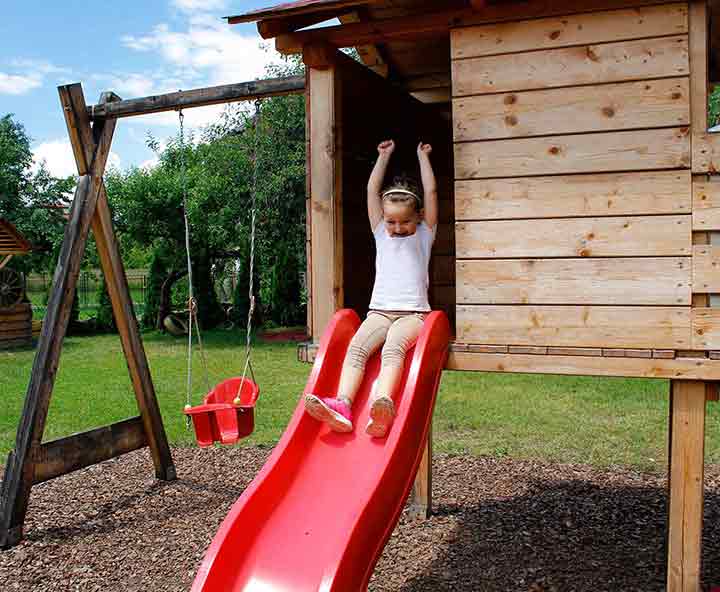By Todd Lewys
So, you’ve been thinking of building a playground for your kids in your backyard.
After all, it’s a concept that makes sense.
With the playground at home, you won’t have to take your kids to a park or play area for them to enjoy some play time - and, if need be, you can supervise your kids (and their friends) from the kitchen while doing chores.
At the same time, building a playground can be a daunting task, especially if you’re not a noted handyman. That said, if you have a plan — and the right tools — building a backyard play paradise for your kids is very doable.
Follow the simple steps set out below, and chances are good your kids —not to mention their friends — will be impressed with your handiwork.
1. Consult your kids. Before you hammer a nail or twist a screw, ask your kids what kind of structures they’d like to have included in their playground. And that’s they key point here: it’s their playground. So, make sure you get their input on its design!
2. Select the site. First of all, the playground area should be in plain view from inside the home. In most cases, kitchen windows overlook backyards, so place the play area in a spot that’s clearly visible from that space. Also, make sure the playground area is level. That will ensure that structures are set solidly on or in the ground, and that kids won’t have to contend with any unexpected tripping hazards.
3. Choose the equipment. This is a critical component in creating a playground that’s appropriate for your children and their friends. Make sure all equipment is a good match for the age of the kids who will be using the playground. Remember, the younger the kids, the safer the playground needs to be. With that in mind, choose simple equipment that isn’t too large for kids to use. Swing sets, slides and sandboxes are always good choices. There should also be no sharp edges, and any landscaping features, i.e., rocks, should be kept out of the play area for obvious safety reasons.
4. Select a safe surface. Because this is an area where kids will be flying around in with abandon, they will inevitably fall down. Consequently, they need a safe, shock-absorbing surface to fall down on to. Choose materials like foam padding or rubber mulch - they are excellent shock absorbers. Also make sure that the cushioned surface extends about six inches from every corner of the playground to maximize safety.
5. Add variety into the equipment mix. Naturally, your kids’ playground will likely incorporate all the usual play structures — a swing set, climbing structure, slide and sandbox. To add interest, consider adding features such as sand (maybe a mini-volleyball court area to encourage kids to jump around and build coordination), a hammock tied up between trees, teeter-totters or climbing rocks with a textured rubber coating for safety. Also, consider using green materials such as cedar or redwood to add visual interest.
6. Put in shelter. Once your kids get into the habit of using their very own private playground, they’ll be outside in the sun on a more consistent basis. To manage sun exposure, build a small shelter — it could also double as a playhouse — to give kids a neat spot where they can get out of the sun for a spell. It doesn’t matter whether the shelter/playhouse is fabricated, made of wood, or is a tent-like structure. What matters is that it gives kids a place to get out of the sun. Once in it, they can continue to play, no matter whether the weather is good, or on the drizzly side!
7. Fence in the play area with a privacy fence. This is a good idea for several reasons. First, a privacy fence — it should be made of pressure-treated wood — is higher than a normal fence, a feature that not only will keep kids out of the area when they’re unsupervised, but will also keep them in a private area that shields them from the uncomfortable gaze of strangers. Such a fence will also keep animals out, too. In short, it will keep the playground secure when it isn’t being used — and when you’re not home to monitor your kids.
8. Take care with landscaping. Of course, building a playground may affect other features in your backyard; features such as landscaping. Seeing as the playground will be a beehive of activity, take care to move flower beds and gardens well away from the area into secure spots. To make them even more secure, consider enclosing those areas with appropriate barriers to mark them clearly as being off-limits!
While building an at-home playground can require a lot of time and effort, doing it — in the long run — will be time well-spent.
Once it’s up and running, you’ll have a wonderful area that’s convenient, saves time and encourages activity.
Most importantly, it will be a safe haven that your kids — and even you — can enjoy. Not only will you be able to monitor your kids while doing dishes in the kitchen, but you can also head outside to engage in activities with your kids — or read a book on a comfy bench that you installed next to the playground in a cool, shady spot!



